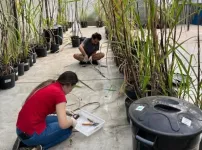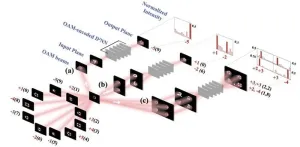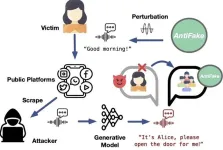(Press-News.org) New research from McMaster University has found that not only is virtual care a safe way to hold medical appointments, but that patients and physicians were able to use it appropriately and effectively with minimal guidance.
The study, published in Healthcare Quarterly on Nov. 27, was led by Shawn Mondoux, an emergency physician and associate professor in the Department of Medicine at McMaster. Mondoux and his team wanted to find out just how safe virtual care is when compared to an in-person assessment.
To do this, researchers keyed in specifically on virtual care in Ontario and utilized data from ICES. This included data from the Ontario Health Insurance Plan (OHIP) database. Virtual care has seen a meteoric rise in use since the beginning of the pandemic and can include video and phone appointments.
Then, to ensure an appropriate comparison, they grouped patients based on several conditions, like age, gender, similar historical illnesses, and their history of diagnosis. This resulted in more than 18 million visits being included in the analysis, split evenly between virtual and in-person care. Researchers then looked at patient outcomes at seven and 30 days following their appointment.
“So the result was that when you look at the two populations together, those who were seen in virtual care had less bad outcomes, had less hospitalization, and less visits to intensive care units, and really had less health care visits, with the exception of one place, which was they tended to see their own family doctors virtually more often than patients seen in-person,” Mondoux says.
It’s important to note that the researchers couldn’t account for the acuity of the patients between the groups in this study.
“So, if you're super sick, you as a patient may in fact choose to say, ‘I'm really sick. This isn't a virtual call thing. I'm going into the emergency department, or I'm going to go see my doctor, or I'm going to go see my specialist.’ And very reasonably, your family physician may also say the same thing. That acuity or that level of sickness isn't something we could totally match for.”
Mondoux says that virtual care is not only safe, but that patients and physicians are making good choices about the use of it.
“The in-person care system is probably taking care of much sicker patients, which is exactly what it should be doing. We released a technology that was brand new. And somehow, everybody just knew how to use it really well.”
Mondoux hopes the research can spur a conversation amongst policymakers about the use of virtual care, by turning the topic away from it being about whether it’s effective, and instead focus on who it is best suited for.
“This can save patients travel to a hospital, parking, and commute time. And there's a lot of patients out there who don't have access to their own vehicle or family members to do all this stuff. So, this is a helpful modality,” he says.
This study received funding from the Juravinski Research Institute and the Graham Farquharson Knowledge Translation Fellowship.
-30-
To arrange an interview with lead author Shawn Mondoux, you can email him directly at mondous@mcmaster.ca.
END
Parents who send their children to child care can breathe a little easier – research published in JAMA Network Open from experts at Michigan Medicine, the University of Pittsburgh School of Medicine, and UPMC Children’s Hospital of Pittsburgh shows that children in daycare were not significant spreaders of COVID-19.
The study found that transmission rates of SARS-CoV-2 within child care centers was only about 2% to 3%, suggesting that children and caregivers were not spreading COVID at significant rates to others ...
To reach the world’s goal of carbon neutrality by 2050, there must be a fundamental change in electronic materials to create a more reliable and resilient electricity grid. A diamond might be a girl’s best friend, but it might also be the solution needed to sustain the electrification of society needed to reach carbon neutrality in the next 30 years. Researchers at the University of Illinois Urbana-Champaign have developed a semiconductor device made using diamond, that has the highest breakdown voltage and lowest leakage current compared to previously reported diamond devices. Such a device will enable more efficient technologies needed as the world transitions to renewable energies.
It ...
Publications on sugarcane have increased exponentially since 2006 worldwide, and Brazil has had more articles published on the topic than any other country in the period, according to a review in BioEnergy Research.
The number of articles on the subject averaged about five per year between 1999 and 2006 but had reached 327 by 2021. Brazil has twice as many articles on sugarcane as the United States, which ranks first in the world for scientific publications in general. Brazil is also ahead of Australia, China and India, which are also major sugarcane growers.
According to the authors of the review, who are affiliated with the Laboratory of Plant Physiological Ecology (LAFIECO) ...
Messenger bubbles produced by human cells can pick up bacterial products and deliver them to other cells, University of Connecticut researchers report in the Nov. 16 issue of Nature Cell Biology. The discovery may explain a key mechanism by which bacteria, whether friendly or infectious, affect our health.
Extra-cellular vesicles (EVs) are like a postal service for our cells. Cells produce the EVs, tiny bubbles with a water-resistant shell made of fatty substances called lipids, and send them into the bloodstream. When another cell comes across an EV, it takes it inside itself ...
Deep learning has revolutionized the way we perceive and utilize data. However, as datasets grow and computational demands increase, we need more efficient ways to handle, store, and process data. In this regard, optical computing is seen as the next frontier of computing technology. Rather than using electronic signals, optical computing relies on the properties of light waves, such as wavelength and polarization, to store and process data.
Diffractive deep neural networks (D2NN) utilize various properties of light waves to perform tasks like image and object recognition. Such networks consist of two-dimensional pixel arrays as diffractive layers. Each pixel serves as an adjustable ...
Many gig workers experienced financial hardships during the COVID-19 pandemic, including food insecurity and trouble paying bills, according to a recent study published in Work and Occupations.
“In a nutshell, our study shows gig workers were harmed more by the COVID-19 pandemic than any other workers,” said Dr. Mathieu Despard, a co-author on the paper and faculty member in UNC Greensboro’s Department of Social Work.
Despard – who collaborated closely with first author Daniel Auguste ...
AURORA, Colo. (Nov. 27, 2023) – Using laboratory engineered tissue, scientists at the University of Colorado Anschutz Medical Campus have created a full thickness, biodegradable patch that holds the promise of correcting congenital heart defects in infants, limiting invasive surgeries and outlasting current patches.
The findings were published this week in the journal Materials Today.
“The ultimate goal is to make lab-grown heart tissue from a patient’s own cells that can be used to restructure the heart to correct for heart defects,” said the ...
Recent advances in generative artificial intelligence have spurred developments in realistic speech synthesis. While this technology has the potential to improve lives through personalized voice assistants and accessibility-enhancing communication tools, it also has led to the emergence of deepfakes, in which synthesized speech can be misused to deceive humans and machines for nefarious purposes.
In response to this evolving threat, Ning Zhang, an assistant professor of computer science and engineering at the McKelvey School of Engineering at Washington University ...
What if a single one-dollar dose could cure cancer?
A multi-university team of researchers, supported by federal funding, is developing a highly efficient bacterial therapeutic to target cancer more precisely to make treatment safer through a single $1 dose.
Traditionally, cancer therapies have been limited in their efficacy in treating patients. Some, like radiation and chemotherapy, cause harmful side effects, while others tend to result in low patient responsiveness, not to mention the cost it takes to receive treatment. Findings from the American Cancer Society Cancer Action Network recorded ...
A new study by Tulane University has uncovered a previously unknown molecular pathway that could be instrumental to halting lung cancer in its tracks.
Lung cancer is one of the most common cancers and the leading cause of cancer-related deaths in the world. The research, published in the journal Proceedings of the National Academy of Sciences, could lead to the development of a new anti-cancer drug and more personalized lung cancer treatment, said senior study author Dr. Hua Lu, the Reynolds and Ryan Families Chair in Translational Cancer at the Tulane University School of Medicine.
The study found ...



